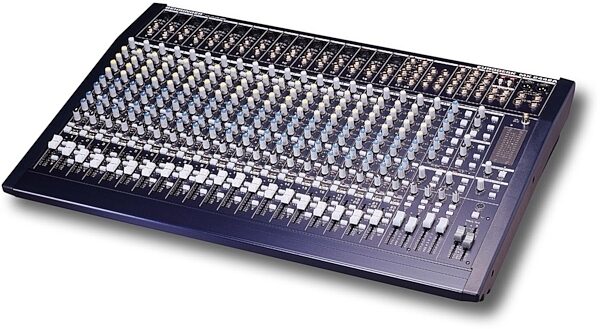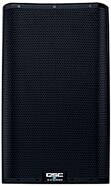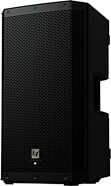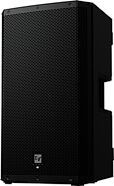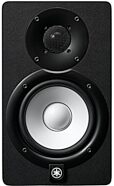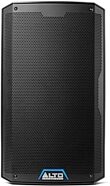Behringer MX2442A Eurodesk Mixer
No longer available at zZounds

zZounds Gear Experts Say...
24-channel (16 mic/4 stereo line) 4 bus console with 6 aux sends per channel (on 4 pots switching pre/post).
Overview
If music is your life, whether it's playing live, recording, or rehearsing, the MX3282A 8-bus and MX2442A 4-bus mixing consoles will turn your idea of what's possible upside down. Both of these mixers can team up with your multitrack or hard disk recorder to create an awesomely powerful combination that's more than able to take on any kind of project that requires "big budget" console performance - at an incredibly affordable price!
Behringer Has Already Redefined Signal Processing.
Behringer has always understood that uncompromised audio quality is the first requirement for any serious console. Why, you ask? Well, you should probably know that, in just a few short years, we've established a new level of performance in analog and digital signal processing. We make sure you get an incredible range of features and great sound at "real world" prices. That's why Behringer processors like the Composer, Autocom, Ultrafex, and Ultra-Curve etc. are "industry standards."
The new Eurodesk live/recording consoles come from the same long hours of hard work, a total dedication to excellence and the total sum of our engineering team's years of experience as professional recording engineers and musicians. "I chose the Eurodesk for tracking the soundtrack to Camera Head. I got all the features and sound I needed for about half the price of the competition." (Greg Noss, Post Production Supervisor, MTV Producer/Composer)
Just Like the Eurodesk Mx8000
Acclaimed as the "Mixer of the Year 1996"… read more (awarded by the German "FACHBLATT MUSIK MAGAZIN" reader's poll 1996), the Eurodesk MX8000 is praised by professionals around the world for its transparent audio, "ultra-musical" EQ and amazing performance for price. We've designed those same great qualities into this series of super rugged consoles so you can count on the MX3282A and MX2442A to deliver a seriously excellent peformance every time you make music.
Mic Preamps that Make a Big Difference
One of the reasons you get great audio performance with the Eurodesk is balanced ULN (Ultra-Low Noise) mic input stages based on high-quality, discrete conjugate transistor pair circuitry. This, plus ultra-wide bandwidth (5 Hz to 100 kHz) and high gain mic preamps, add up to a dramatic increase in headroom and superior noise performance at all gain settings.
More Headroom for Better-Sounding Tracks
Speaking of headroom, having more than enough of it is critically important in tracking and mixdown. In combination with the Eurodesk's generous external 19 in. power supply and specially planned gain structure that runs at a professional level of +4 dBu instead of the more amateurish -10 dBV ensures maximum headroom in any situation, no matter how much the gain mix amps are overloaded. With this setup, even a huge 30-piece classical orchestra with a massive brass and percussion section can't overload this board!
More Aux Sends to Give You More Flexibility
If you're seriously into mixing, you need as many aux sends as you can get. The Eurodesk MX3282A features 8 aux sends per channel, for all the flexibility you need! With these additional aux sends, you'll always have the flexibility to handle a multitude of tasks in recording and live mix situations. If you're mixing live, you need a lot of pre fader auxes to use as monitor sends. For this application, you've got the choice of 6 pre fader aux sends (2 or 6 on the MX2442A) and 2 post fader aux sends (4 or none on the MX2442A) for your effects. Recording is a slightly different story. In the studio you'll want post fader auxes to use for that huge rack of effects in your "control room." You'll also want pre fader auxes to use for your headphone mixes. With the MX3282A, you can have up to 8 auxes to best accomplish your needs, and up to 6 auxes with the MX2442A. How, you might ask, can we possibly get all of these aux sends into one console? Easy. On the Eurodesk MX3282A auxes 1 & 2 are pre fader, and 3 & 4 are post fader. The remaining auxes 5 to 8 are swichable pro or post fader and they also feature a "shift" switch that can assign a shared pair of level controls to either aux 5 and 6 as a pair or 7 and 8.
Transport Your Music Anywhere with Either 8 or 4 Buses
The MX3282A is a true 8-bus live/recording console, while the MX2442A is a true 4-bus! This means you can arrange or "group" different combinations of either 32 or 24 channels to either 8 or 4 mono subgroup buses respectively, depending on the console you're using. This way, you can group a number of different instrument or vocal sources together into "subgroups" and control the level for all of them with one subgroup fader. Even better, each subgroup has its own individual output and features additional Pan (to "pan" the signal from left to right in the stereo mix) and Solo controls (to solo or isolate individual signals). Also, each subgroup can be assigned to the Main Mix. "To me, when something is transparent, it's not necessarily musical. That's what impressed me about the Eurodesk. The fact that it was transparent but the EQ was ver musical, very sweet sounding. It has great headroom and the musical sounding EW is very important for the kind of work I do." (Richard Mullen, Producer/Eng., Stevie Ray Vaughan, Eric Johnson)
ULN Circuitry Provides Ultra Quiet 8-Bus Performance
Acclaimed in product tests as an "ultra-quiet console," the Eurodesk benefits from Behringer's exclusive ULN (Ultra-Low Noise) low impedance design to reduce thermal noise and crosstalk to a minimum. This, combined with the superior 4580 operational amplifiers produces quiet performance that sets standards! Don't forget that each and every Behringer mixer is equipped with these state of the art NJM4580 op amps.
Not Just More EQ, More "Musical" EQ
Some manufacturers talk about how much EQ they have in their mixing consoles. The problem is quantity doesn't necessarily mean quality! That's why other consoles in this class have EQ sections with a harsh, strident sound, something you don't want when you're recording or mixing music. The Eurodesk MX8000 has already distinguished itself with an EQ section that has been described as "ultra-musical" by discriminating professionals such as Richard Mullen, engineer/producer for Eric Johnson, an exceptionally creative and tone-conscious guitarist/composer from Texas. This same "musical" EQ is a critical component of both the MX3282A and MX2442A. In order to give you the best possible sound quality at all times, each of the mono channels is equipped with Lo and Hi Shelving EQ at 80 Hz and 12 kHz respectively, plus a semi parametric 3-band, "Constant Q" EQ with midrange sweepable from 100 Hz to 8 kHz. The numbers don't really matter much in the end. What's important to you is the fact that this design results in the superior "musical" sound referred to earlier. The stereo channels on these mixers feature comprehensive and great sounding 4-band EQ with 2 mid-band frequencies fixed at 500 Hz and 3 kHz. +15 dB of boost and cut is available on all channels to give you a wide range of control.
150 Watt Power Supply a "Discriminating" Low Cut Filter
When it comes to getting great live sound, you definitely don't want stage rumble, occasional "thumps" in the night and other low frequency noise intruding on your mix. That's why we've included a very steep 75 Hz low cut filter (18 dB per octave) to virtually eliminate all of those annoying and unwelcome sounds from the program material. This "discriminating" low cut filter also lets you beef up thin, characterless vocal and instrument parts with additional low frequency information.
Professional Features You Will Need
The talkback section has a mic that's built in, not left out. The design for both Eurodesk consoles was carefully thought out so that no feature you need was left out. This includes critically important stuff like an internal talkback mic with an assign section that you can route to 6 of the 8 aux sends (like the pre fader cue sends, for example) so that you can always communicate with performers via the monitors.
Monitoring to the Max
Both Eurodesks also have individual stereo level controls to adjust the levels of the studio and control room monitors, with levels adjusted post the Main Mix faders. A sourcing matrix lets you listen to any or all of the Main Mix, 2-track and external inputs, while a Mono switch sums the left and right Mix channels so you can easily check phase coherency. Equipped with its own level control, "Solo" allows control room or studio speakers to monitor the musicians' headphone mix. Two stereo headphone outputs on the rear panel (which avoids problems with headphone cords getting tangled up with any of the controls) also have a separate level control. A switch lets you route the stereo tape return to the control room or headphones so you can monitor the 2-track recording.
Getting Back to the Main Mix
This versatile console also gives you the ability to route the Tape Returns to the Main Left/Right outputs and also disengages all of the other inputs to the Mains so you can play music between sets without readjusting your level settings.
4 Fully Assignable Stereo Aux Returns
The Eurodesk has 4 balanced stereo aux returns. In addition, the aux returns are fully assignable to subgroups, with a solo switch and balance controls.
Setting Levels With No Sweat
The "Solo" function lets you audition the output of any channel post fader on the stereo Solo bus, muting all other sources. In order to get maximum headroom with low noise, you press the Solo control and set the fader to unity gain. You'll see the actual operating level of the channel on the main LED meters. All you have to do is use the Gain controls to bring the signal peaks to 0 dB and you'll end up with a low noise floor and more headroom.
See What You Hear
Because you always need to know the signal status, the Eurodesk has both Signal Present (-20 dB) and Clip (+20 dB) LED indicators that accurately track the signal.
Inserts and Outputs
Mono channels, subgroups, and Main Mix all feature channel inserts to patch in external processors and other outboard gear. The console also has Main L/R outputs on both XLR and TRS connectors. All outputs operate at maximum levels of +28 dBu (XLR) and +22 dBu (TRS). "Behringer's reputation for outstanding audio quality was my consideration. I love your equipment." (CK, Los Angeles)
Before and After Pre Fader and After Fader Listen
On the Eurodesks, you can switch between both the PFL (Pre Fader Listen) and Solo (Solo In Place) modes. PFL lets you monitor the signal at maximum levels before it gets to the faders so you can make sure it's present without affecting the fader position. You can use Solo to determine where a signal is positioned in the stereo sound stage before panning the signal. Isolating the signal this way makes it easier to hear low level pans.
Built to Last!
A rigid monocoque chassis and thick PC board provides superior mechanical stability for the life of the console. With sealed pots and true logarithmic faders used throughout, you can be sure of precision control that remains consistently true year after year, show after show, session after session. The Eurodesk even has a BNC lamp socket to facilitate work in darkened recording or live sound environments!
Details, Details, Details
Take our "punishment-proof" pots for example. We use horizontally mounted PCBs which provide benefits like less wiring, simplified internal construction, improved overall reliability and superior sound quality thanks to the shortened signal paths. To understand why this is, consider the vertically mounted input channel PCB approach used on other consoles, even on many "big budget" designs. If the body of the potentiometer is mounted at right angles to the plane of the circuit board itself, a vertical impact or steady pressure subjects the pots solder joints to shear forces that can seriously impair the integrity of the electrical connection between control and board, leading to fracture and failure. With the Eurodesk however, the potentiometers spindle sits perpendicularly to the horizontal circuit board beneath it. Any unexpected vertical impact is first absorbed by the skirt of the control knob itself that sits just clear of the sheet metal of the console chassis. Any residual force then pushes the potentiometer against the circuit beneath it, absorbing the impact - no force is applied to the solder joints and the integrity of the electrical connection is maintained. Match this insistence on the highest construction standards with the world's finest components specially selected by Behringer and you have a pretty good idea of the MX3282A. Compare this to other consoles in its class and above.
Accurate Signal Placement
The Main Mix and/or any of the 4 subgroup pairs can be easily selected with 5 assign switches arranged as a vertical routing matrix alongside the channel fader. Channel Pan precisely positions the output of the channel in the stereo field. Its constant-power design ensures pinpoint panoramic placement, a real revelation if you've been working on consoles with inferior circuitry! All stereo buses follow Channel Pan and Solo. Mute and Solo/PFL have been ergonomically placed immediately above the channel fader with an LED for visual status indication.
Professional Control at Every Level
Main output level is controlled via a pair of high-quality Panasonic 60 mm faders for an ultra-smooth fade typically found on very expensive, large frame consoles. The monitor or control room output is independently adjustable for level. The master section also includes an assignable headphone output with gain control and a 2-track tape return which is assignable to Monitor and Headphones.
Is It for Live or for Recording
Having been taken through a detailed rundown of the MX3282A and MX2442A consoles, you really only have one big problem to grapple with. Are these mixers better for live applications or recording situations? Actually, there's no problem. They deliver truly exceptional performance for both.
We've thought about the design so you can focus on the music. When you mix with a Behringer Eurodesk, it's easy to forget you're not using a console that costs many times the price. It's great to have more features than you can shake an XLR connector at, but with the Eurodesk series from Behringer, we haven't forgotten that your investment is likely to suffer some serious abuse at the hands of live sound engineers and roadies during its long and productive lifespan. With this in mind, we've designed our live consoles around the same steel monocoque chassis as every other Eurodesk for strength and durability...the affordable answer that sounds like a million dollars! read less
Behringer Has Already Redefined Signal Processing.
Behringer has always understood that uncompromised audio quality is the first requirement for any serious console. Why, you ask? Well, you should probably know that, in just a few short years, we've established a new level of performance in analog and digital signal processing. We make sure you get an incredible range of features and great sound at "real world" prices. That's why Behringer processors like the Composer, Autocom, Ultrafex, and Ultra-Curve etc. are "industry standards."
The new Eurodesk live/recording consoles come from the same long hours of hard work, a total dedication to excellence and the total sum of our engineering team's years of experience as professional recording engineers and musicians. "I chose the Eurodesk for tracking the soundtrack to Camera Head. I got all the features and sound I needed for about half the price of the competition." (Greg Noss, Post Production Supervisor, MTV Producer/Composer)
Just Like the Eurodesk Mx8000
Acclaimed as the "Mixer of the Year 1996"… read more (awarded by the German "FACHBLATT MUSIK MAGAZIN" reader's poll 1996), the Eurodesk MX8000 is praised by professionals around the world for its transparent audio, "ultra-musical" EQ and amazing performance for price. We've designed those same great qualities into this series of super rugged consoles so you can count on the MX3282A and MX2442A to deliver a seriously excellent peformance every time you make music.
Mic Preamps that Make a Big Difference
One of the reasons you get great audio performance with the Eurodesk is balanced ULN (Ultra-Low Noise) mic input stages based on high-quality, discrete conjugate transistor pair circuitry. This, plus ultra-wide bandwidth (5 Hz to 100 kHz) and high gain mic preamps, add up to a dramatic increase in headroom and superior noise performance at all gain settings.
More Headroom for Better-Sounding Tracks
Speaking of headroom, having more than enough of it is critically important in tracking and mixdown. In combination with the Eurodesk's generous external 19 in. power supply and specially planned gain structure that runs at a professional level of +4 dBu instead of the more amateurish -10 dBV ensures maximum headroom in any situation, no matter how much the gain mix amps are overloaded. With this setup, even a huge 30-piece classical orchestra with a massive brass and percussion section can't overload this board!
More Aux Sends to Give You More Flexibility
If you're seriously into mixing, you need as many aux sends as you can get. The Eurodesk MX3282A features 8 aux sends per channel, for all the flexibility you need! With these additional aux sends, you'll always have the flexibility to handle a multitude of tasks in recording and live mix situations. If you're mixing live, you need a lot of pre fader auxes to use as monitor sends. For this application, you've got the choice of 6 pre fader aux sends (2 or 6 on the MX2442A) and 2 post fader aux sends (4 or none on the MX2442A) for your effects. Recording is a slightly different story. In the studio you'll want post fader auxes to use for that huge rack of effects in your "control room." You'll also want pre fader auxes to use for your headphone mixes. With the MX3282A, you can have up to 8 auxes to best accomplish your needs, and up to 6 auxes with the MX2442A. How, you might ask, can we possibly get all of these aux sends into one console? Easy. On the Eurodesk MX3282A auxes 1 & 2 are pre fader, and 3 & 4 are post fader. The remaining auxes 5 to 8 are swichable pro or post fader and they also feature a "shift" switch that can assign a shared pair of level controls to either aux 5 and 6 as a pair or 7 and 8.
Transport Your Music Anywhere with Either 8 or 4 Buses
The MX3282A is a true 8-bus live/recording console, while the MX2442A is a true 4-bus! This means you can arrange or "group" different combinations of either 32 or 24 channels to either 8 or 4 mono subgroup buses respectively, depending on the console you're using. This way, you can group a number of different instrument or vocal sources together into "subgroups" and control the level for all of them with one subgroup fader. Even better, each subgroup has its own individual output and features additional Pan (to "pan" the signal from left to right in the stereo mix) and Solo controls (to solo or isolate individual signals). Also, each subgroup can be assigned to the Main Mix. "To me, when something is transparent, it's not necessarily musical. That's what impressed me about the Eurodesk. The fact that it was transparent but the EQ was ver musical, very sweet sounding. It has great headroom and the musical sounding EW is very important for the kind of work I do." (Richard Mullen, Producer/Eng., Stevie Ray Vaughan, Eric Johnson)
ULN Circuitry Provides Ultra Quiet 8-Bus Performance
Acclaimed in product tests as an "ultra-quiet console," the Eurodesk benefits from Behringer's exclusive ULN (Ultra-Low Noise) low impedance design to reduce thermal noise and crosstalk to a minimum. This, combined with the superior 4580 operational amplifiers produces quiet performance that sets standards! Don't forget that each and every Behringer mixer is equipped with these state of the art NJM4580 op amps.
Not Just More EQ, More "Musical" EQ
Some manufacturers talk about how much EQ they have in their mixing consoles. The problem is quantity doesn't necessarily mean quality! That's why other consoles in this class have EQ sections with a harsh, strident sound, something you don't want when you're recording or mixing music. The Eurodesk MX8000 has already distinguished itself with an EQ section that has been described as "ultra-musical" by discriminating professionals such as Richard Mullen, engineer/producer for Eric Johnson, an exceptionally creative and tone-conscious guitarist/composer from Texas. This same "musical" EQ is a critical component of both the MX3282A and MX2442A. In order to give you the best possible sound quality at all times, each of the mono channels is equipped with Lo and Hi Shelving EQ at 80 Hz and 12 kHz respectively, plus a semi parametric 3-band, "Constant Q" EQ with midrange sweepable from 100 Hz to 8 kHz. The numbers don't really matter much in the end. What's important to you is the fact that this design results in the superior "musical" sound referred to earlier. The stereo channels on these mixers feature comprehensive and great sounding 4-band EQ with 2 mid-band frequencies fixed at 500 Hz and 3 kHz. +15 dB of boost and cut is available on all channels to give you a wide range of control.
150 Watt Power Supply a "Discriminating" Low Cut Filter
When it comes to getting great live sound, you definitely don't want stage rumble, occasional "thumps" in the night and other low frequency noise intruding on your mix. That's why we've included a very steep 75 Hz low cut filter (18 dB per octave) to virtually eliminate all of those annoying and unwelcome sounds from the program material. This "discriminating" low cut filter also lets you beef up thin, characterless vocal and instrument parts with additional low frequency information.
Professional Features You Will Need
The talkback section has a mic that's built in, not left out. The design for both Eurodesk consoles was carefully thought out so that no feature you need was left out. This includes critically important stuff like an internal talkback mic with an assign section that you can route to 6 of the 8 aux sends (like the pre fader cue sends, for example) so that you can always communicate with performers via the monitors.
Monitoring to the Max
Both Eurodesks also have individual stereo level controls to adjust the levels of the studio and control room monitors, with levels adjusted post the Main Mix faders. A sourcing matrix lets you listen to any or all of the Main Mix, 2-track and external inputs, while a Mono switch sums the left and right Mix channels so you can easily check phase coherency. Equipped with its own level control, "Solo" allows control room or studio speakers to monitor the musicians' headphone mix. Two stereo headphone outputs on the rear panel (which avoids problems with headphone cords getting tangled up with any of the controls) also have a separate level control. A switch lets you route the stereo tape return to the control room or headphones so you can monitor the 2-track recording.
Getting Back to the Main Mix
This versatile console also gives you the ability to route the Tape Returns to the Main Left/Right outputs and also disengages all of the other inputs to the Mains so you can play music between sets without readjusting your level settings.
4 Fully Assignable Stereo Aux Returns
The Eurodesk has 4 balanced stereo aux returns. In addition, the aux returns are fully assignable to subgroups, with a solo switch and balance controls.
Setting Levels With No Sweat
The "Solo" function lets you audition the output of any channel post fader on the stereo Solo bus, muting all other sources. In order to get maximum headroom with low noise, you press the Solo control and set the fader to unity gain. You'll see the actual operating level of the channel on the main LED meters. All you have to do is use the Gain controls to bring the signal peaks to 0 dB and you'll end up with a low noise floor and more headroom.
See What You Hear
Because you always need to know the signal status, the Eurodesk has both Signal Present (-20 dB) and Clip (+20 dB) LED indicators that accurately track the signal.
Inserts and Outputs
Mono channels, subgroups, and Main Mix all feature channel inserts to patch in external processors and other outboard gear. The console also has Main L/R outputs on both XLR and TRS connectors. All outputs operate at maximum levels of +28 dBu (XLR) and +22 dBu (TRS). "Behringer's reputation for outstanding audio quality was my consideration. I love your equipment." (CK, Los Angeles)
Before and After Pre Fader and After Fader Listen
On the Eurodesks, you can switch between both the PFL (Pre Fader Listen) and Solo (Solo In Place) modes. PFL lets you monitor the signal at maximum levels before it gets to the faders so you can make sure it's present without affecting the fader position. You can use Solo to determine where a signal is positioned in the stereo sound stage before panning the signal. Isolating the signal this way makes it easier to hear low level pans.
Built to Last!
A rigid monocoque chassis and thick PC board provides superior mechanical stability for the life of the console. With sealed pots and true logarithmic faders used throughout, you can be sure of precision control that remains consistently true year after year, show after show, session after session. The Eurodesk even has a BNC lamp socket to facilitate work in darkened recording or live sound environments!
Details, Details, Details
Take our "punishment-proof" pots for example. We use horizontally mounted PCBs which provide benefits like less wiring, simplified internal construction, improved overall reliability and superior sound quality thanks to the shortened signal paths. To understand why this is, consider the vertically mounted input channel PCB approach used on other consoles, even on many "big budget" designs. If the body of the potentiometer is mounted at right angles to the plane of the circuit board itself, a vertical impact or steady pressure subjects the pots solder joints to shear forces that can seriously impair the integrity of the electrical connection between control and board, leading to fracture and failure. With the Eurodesk however, the potentiometers spindle sits perpendicularly to the horizontal circuit board beneath it. Any unexpected vertical impact is first absorbed by the skirt of the control knob itself that sits just clear of the sheet metal of the console chassis. Any residual force then pushes the potentiometer against the circuit beneath it, absorbing the impact - no force is applied to the solder joints and the integrity of the electrical connection is maintained. Match this insistence on the highest construction standards with the world's finest components specially selected by Behringer and you have a pretty good idea of the MX3282A. Compare this to other consoles in its class and above.
Accurate Signal Placement
The Main Mix and/or any of the 4 subgroup pairs can be easily selected with 5 assign switches arranged as a vertical routing matrix alongside the channel fader. Channel Pan precisely positions the output of the channel in the stereo field. Its constant-power design ensures pinpoint panoramic placement, a real revelation if you've been working on consoles with inferior circuitry! All stereo buses follow Channel Pan and Solo. Mute and Solo/PFL have been ergonomically placed immediately above the channel fader with an LED for visual status indication.
Professional Control at Every Level
Main output level is controlled via a pair of high-quality Panasonic 60 mm faders for an ultra-smooth fade typically found on very expensive, large frame consoles. The monitor or control room output is independently adjustable for level. The master section also includes an assignable headphone output with gain control and a 2-track tape return which is assignable to Monitor and Headphones.
Is It for Live or for Recording
Having been taken through a detailed rundown of the MX3282A and MX2442A consoles, you really only have one big problem to grapple with. Are these mixers better for live applications or recording situations? Actually, there's no problem. They deliver truly exceptional performance for both.
We've thought about the design so you can focus on the music. When you mix with a Behringer Eurodesk, it's easy to forget you're not using a console that costs many times the price. It's great to have more features than you can shake an XLR connector at, but with the Eurodesk series from Behringer, we haven't forgotten that your investment is likely to suffer some serious abuse at the hands of live sound engineers and roadies during its long and productive lifespan. With this in mind, we've designed our live consoles around the same steel monocoque chassis as every other Eurodesk for strength and durability...the affordable answer that sounds like a million dollars! read less
Specs
Main Channel Strip
Mic input: electronically balanced, discrete input configuration
Mic E.I.N.: (22 Hz to 22 kHz) -129.5 dBu, 150 Ohms source
-117.3 dBqp, 150 Ohms source
-132.0 dBu, input shorted
-122.0 dBqp, input shorted
Distortion: (THD & N) 0.007 % at +4 dBu, 1 kHz, bandwidth 80 kHz
Gain range: +10 dB to +60 dB
Max. input: +12 dBu
Line input: electronically balanced
Sensitivity range: +10 dBu to -40 dB
Max. input: +22 dBu
Channel fader range: +10 dB to -85 dB / off
Aux send gain range: off to unity to +15 dB
Equalisation
Hi shelving: 12 kHz, +/- 15 dB, Q fixed at 2 oct.
Hi mid bell: (ch. 17 to 24) 3 kHz, +/- 15 dB, Q fixed at 2 oct.
Mid sweep: (ch. 1 to 16) 100 Hz to 8 kHz, +/- 15 dB, Q fixed at 2 oct.
Lo mid bell: (ch. 17 to 24) 500 Hz, +/- 15 dB, Q fixed at 2 oct.
Lo shelving: 80 Hz, +/- 15 dB, Q fixed at 2 oct.
Lo cut: (HPF) 75 Hz, 18 dB/oct.
Channel Insert
Max. in/out: +22 dBu
Channel to channel crosstalk: -95 dB @ 1 kHz
Subgroup Section
Noise: bus noise @ fader 0 dB:
-105.0 dBr (ref. +4 dBu)
-92.0 dBr (ref. +4 dBu, all input ch. assigned, unity gain, ch. muted)
-87.0 dBr (ref. +4 dBu, all input ch. assigned, unity gain)
Submaster output: max. out +22 dBu balanced/unbalanced
Fader range: +10 dB to -85 dB / off
Main Mix Section
Noise: bus noise @ fader 0 dB:
-103.0 dBr (ref. +4 dBu)
-92.0 dBr (ref. +4 dBu, all input ch. assigned, unity gain, ch. muted)
-87.0 dBr (ref. +4 dBu, all input ch. assigned, unity gain)
Max. output: +28 dBu balanced, +22 dBu unbalanced
Aux returns gain range off to unity to +20 dB
Aux sends max. out +22 dBu
General
Distortion: (THD & N) 0.007 %, @ +4 dBu, 1 kHz, bandwidth 80 kHz
Frequency response: 20 Hz to 40 kHz, +/- 1 dB any input to any output
10 Hz to 120 kHz, +/- 3 dB
Power Supply
External power supply: 150 Watts, 19" (482.6 mm), 2 rack units, approx. 7 kg
Physical
Dimensions: Height 55, 105mm (2.17, 4.1") x Width 720mm (28.4") x Depth 500mm (19.7")
Weight: approximately 12 kg (without PSU)
Mic input: electronically balanced, discrete input configuration
Mic E.I.N.: (22 Hz to 22 kHz) -129.5 dBu, 150 Ohms source
-117.3 dBqp, 150 Ohms source
-132.0 dBu, input shorted
-122.0 dBqp, input shorted
Distortion: (THD & N) 0.007 % at +4 dBu, 1 kHz, bandwidth 80 kHz
Gain range: +10 dB to +60 dB
Max. input: +12 dBu
Line input: electronically balanced
Sensitivity range: +10 dBu to -40 dB
Max. input: +22 dBu
Channel fader range: +10 dB to -85 dB / off
Aux send gain range: off to unity to +15 dB
Equalisation
Hi shelving: 12 kHz, +/- 15 dB, Q fixed at 2 oct.
Hi mid bell: (ch. 17 to 24) 3 kHz, +/- 15 dB, Q fixed at 2 oct.
Mid sweep: (ch. 1 to 16) 100 Hz to 8 kHz, +/- 15 dB, Q fixed at 2 oct.
Lo mid bell: (ch. 17 to 24) 500 Hz, +/- 15 dB, Q fixed at 2 oct.
Lo shelving: 80 Hz, +/- 15 dB, Q fixed at 2 oct.
Lo cut: (HPF) 75 Hz, 18 dB/oct.
Channel Insert
Max. in/out: +22 dBu
Channel to channel crosstalk: -95 dB @ 1 kHz
Subgroup Section
Noise: bus noise @ fader 0 dB:
-105.0 dBr (ref. +4 dBu)
-92.0 dBr (ref. +4 dBu, all input ch. assigned, unity gain, ch. muted)
-87.0 dBr (ref. +4 dBu, all input ch. assigned, unity gain)
Submaster output: max. out +22 dBu balanced/unbalanced
Fader range: +10 dB to -85 dB / off
Main Mix Section
Noise: bus noise @ fader 0 dB:
-103.0 dBr (ref. +4 dBu)
-92.0 dBr (ref. +4 dBu, all input ch. assigned, unity gain, ch. muted)
-87.0 dBr (ref. +4 dBu, all input ch. assigned, unity gain)
Max. output: +28 dBu balanced, +22 dBu unbalanced
Aux returns gain range off to unity to +20 dB
Aux sends max. out +22 dBu
General
Distortion: (THD & N) 0.007 %, @ +4 dBu, 1 kHz, bandwidth 80 kHz
Frequency response: 20 Hz to 40 kHz, +/- 1 dB any input to any output
10 Hz to 120 kHz, +/- 3 dB
Power Supply
External power supply: 150 Watts, 19" (482.6 mm), 2 rack units, approx. 7 kg
Physical
Dimensions: Height 55, 105mm (2.17, 4.1") x Width 720mm (28.4") x Depth 500mm (19.7")
Weight: approximately 12 kg (without PSU)
Documents and Manuals
For support or warranty questions, please contact the manufacturer:
Web: https://www.behringer.com/service.html
Web: https://www.behringer.com/service.html
Reviews
Reviewers gave this product an overall rating of 4.5 out of 5 stars.
(74 ratings)
Submitted January 5, 2005 by a customer from yahoo.com
"{"
Verified Purchaser
zZounds has verified that this reviewer purchased this specific product from us.
This is a nice board. I will have it for awhile. I have many behringer products (compressors, mixers, monitors, guitar amp, etc.) If I would have bought the "good stuff" I would probly have spent easily twice as much, if not more.
Sound
Very clean sound. Much cleaner than I had imagined it being. Nice adjustable eq. There is still a bunch I need to learn about what this board can do.
Features
Lots of knobs. I don't use them all, because I don't really know what they all do yet. would have been nice to have built in effects.
Quality
Very nice quality. The box that it came in wasn't that great, but the mixer is very clean. very solid. I don't plan on moving it very much, nor dropping it. The knobs seem nice. When I first moved the faders they had some pressure to them, now they move nice and smooth.
Value
Behringer is always good with pricing. They're priced so low, because they don't have research teams. They steal other companies ideas, like Mackie and shure and the like. Once Mackie goes out of business, Behringer goes.
Manufacturer Support
Never have needed help.
The Wow Factor
Makes my homestudio look nice.
Musical Background:
hobbyist, musician, recording, etc.
Musical Style:
Rock, Punk, Alternative
2 of 5 people (40%) people found this review helpful. Did you?
Thanks for your opinion!
No longer available at zZounds
In most cases, a product is unavailable because it has been discontinued by the manufacturer
This is a carousel with product cards. Use the previous and next buttons to navigate.
